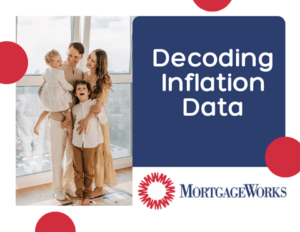Figuring out Mortgage Rates can seem like a daunting task.
Many prospective buyers find themselves at a loss. This confusion often separates the uninformed buyer from the savvy homeowner.
If you’re not equipped with knowledge about mortgage rates and how they work, reaching that level of homeownership mastery seems impossible.
Navigating through mortgage rates is challenging. Consider, for instance, one aspiring homeowner who shared his experience – as soon as he thought he had figured out his ideal rate… market fluctuations caused it to skyrocket overnight!
The fear of such unpredictability may discourage him from taking that crucial step toward owning a home again. Can’t blame him!
Unraveling the complexities of mortgage rates can be a tricky endeavor, yet comprehending how they are determined could aid you in getting an advantageous interest rate for your home loan. A prevalent misconception is that lenders independently set their own mortgage rates; however, these figures are primarily influenced by financial market movements.
This means borrowers should be aware not only of housing market trends but also of broader economic indicators when considering taking out a home loan. For instance, if there’s high demand leading to potential increases in housing prices soon, securing today’s lower refinance closing costs could prove beneficial.
Credit Scores Impact on Interest Rates
Your credit score plays a significant role, too; higher scores generally lead to better offers from lenders as they pose less risk. Borrowers with good credit tend to get offered great low-interest rate deals because they’re seen as less likely to default on repayments.
Adjustable-Rate Mortgages: An Overview
Borrowers might want to consider adjustable-rate mortgages, which offer attractive introductory rate options at first glance but may fluctuate over time depending upon changes in benchmark interest levels. This guide provides detailed insights into this aspect of securing advantageous terms for your home loan.
The Bond Market’s Influence on Mortgage Rates
Mortgage rates and the bond market share a significant relationship. The 10-year Treasury yield is typically utilized as a reference point for long-term borrowing rates, including mortgages. In simpler terms, when these bond yields rise or fall, mortgage rates tend to follow suit.
When Fitch downgraded the U.S. treasury debt, the 10-year bond yield rose to over 4.20%, leading to higher mortgage interest rates. This event subsequently triggered an escalation in mortgage lenders’ set interest rates.
Understanding Bond Yields
Bond yields are essentially indicative of what investors anticipate earning from their investment if held until maturity. An inverse correlation exists between bond prices and yields, meaning that when prices escalate, yields decrease and vice versa.
This reverse association arises because new bonds issued at higher interest levels than existing ones (due possibly to inflationary pressures) render older bonds less attractive, thus necessitating them being sold at reduced prices so they can remain competitive while reflecting their lower return relative to newer offerings available within the housing market.
In the context of your home loan expenses: When there’s an upswing in bond yields – suggesting investors require greater returns due to riskier economic conditions – you’ll notice lending costs rising through increased mortgage APRs, thereby making housing more expensive overall. Conversely, should those same indicators suggest stability ahead, lowering investor-required returns, then expect corresponding reductions within borrowing charges like adjustable-rate mortgages, hence enhancing affordability.
Economic Indicators and Their Impact on Mortgage Rates
Understanding the influence of economic indicators on mortgage rates is crucial for individuals entering the housing market. These figures provide insights into the state of our economy, which can ultimately affect interest rates.
Decoding Inflation Data

Inflation data plays a significant role in determining mortgage rates. The CPI and PPI, two important gauges of inflation, measure changes in the prices of goods and services over time.
The CPI monitors changes in consumer prices, while the PPI tracks wholesale price levels before they reach consumers. When these indices rise, it indicates increasing inflationary pressures that could lead to higher interest rates as lenders try to offset the reduced purchasing power caused by inflation.
A notable example occurred when the July CPI report showed a slightly lower-than-expected increase of 3.2%. This figure may have eased concerns about rampant inflation, which could have resulted in skyrocketing mortgage rates.
Jobless Claims as an Economic Indicator
Initial jobless claims also serve as a vital economic indicator that influences mortgage rate trends. An increase or decrease in jobless claims often indicates potential shifts in the labor market, which can impact overall economic health.
For instance, if there is an uptick in initial jobless claims, as seen in July with numbers rising to 248,000, it may suggest weakened employment conditions that could slow down economic growth. In such scenarios, interest rates tend to decrease, assuming all other factors remain constant.
In essence, understanding these key indicators helps prospective homebuyers anticipate possible fluctuations that could affect their ability to secure favorable terms when borrowing money from mortgage markets approved by the Consumer Financial Protection Bureau.
Decoding FHA Mortgage Insurance
The landscape of home loans is complex, with Federal Housing Administration (FHA) mortgage insurance being a critical element that borrowers must comprehend. This specific type of insurance safeguards lenders against losses if the borrower fails to meet their loan obligations.
In essence, individuals with lower credit scores may find an edge in securing an FHA loan as these do not place significant emphasis on credit scores compared to conventional mortgages.
Borrower Advantages and Cost Reduction Strategies
HomeReady Program and HomePossible Program both offer promising avenues for reducing costs associated with FHA loans. These programs aim to make homeownership more affordable by offering reduced rates on mortgage insurance, among other benefits.
FHA’s flexible guidelines allow those rebuilding their financial health after setbacks like bankruptcy or foreclosure access to borrow money under its program.
This makes it a great option for first-time purchasers who could have lower credit ratings.
MortgageWorks experts help navigate through this intricate process providing tailored solutions based on individual needs.
The Advantage of Small Loan Balances
With the fluctuating housing market, small loan balances have emerged as a viable option for many potential homeowners. The favorable mortgage interest rates and improved pricing options associated with these loans make them an appealing choice.
Better Pricing Options: Buydowns Explained

Apart from competitive pricing options, borrowers also stand to benefit from ‘buydowns.’ A buydown is essentially paying additional upfront points to secure a reduced overall interest rate on your home loan.
If you’re fortunate enough to have extra cash during closing time, investing it through a buydown process could result in substantial savings over the course of your mortgage term by lowering monthly payments. This strategy underscores how understanding the intricacies of adjustable-rate mortgages can be beneficial.
Favorable Mortgage Interest Rates: Impact on Smaller Loans
MortgageWorks offers enticing rates even for smaller mortgages, which are particularly advantageous for prospective buyers scouting properties within the Coachella Valley’s vibrant housing market. However, focusing solely on securing a great low-interest rate may not always yield long-term benefits.
Analyze all factors, such as adjustable-rate terms or introductory offers, before settling down with any particular lender or type of home loan product.
Understand that short-term costs like down payment requirements and long-term expenses, including the total amount paid toward interest, will significantly affect your financial health.
Prioritize finding out about lower refinance closing costs along with other charges when choosing lending institutions offering similar services within today’s dynamic housing market.
The Fed Funds Rate vs. Mortgage Rates
Contrary to popular belief, the Federal Reserve’s interest rate decisions do not necessarily dictate mortgage rates. While it is accurate to say that the Fed funds rate affects short-term loan and credit card interest rates, its influence over long-term loans such as mortgages isn’t straightforward.
In reality, factors like inflation data, economic growth indicators, and bond market conditions hold more sway when mortgage lenders determine their lending rates. For instance, fixed-rate mortgages tend to correlate closer with the 10-year Treasury yield than they do with federal fund rates.
Bond Market Influence Over Mortgage Rates Explained
An increase in bond yields typically results in higher mortgage interest rates. This happens because bonds and home loans attract similar types of investors who seek safe returns at steady intervals. When bond yields rise due to changes in financial markets or monetary policy adjustments by central banks globally, this prompts mortgage lenders to raise their own interests accordingly to stay competitive within the housing market landscape.
This means that even if there’s any downward adjustment made by the Fed lowering its target rate – which generally makes borrowing cheaper overall – your potential good mortgage rate may not necessarily follow suit, especially if other influential elements like rising bond yields are involved concurrently.
Fed Policy Impacts on Adjustable-Rate Mortgages (ARMs)
Adjustable-rate mortgages (ARMs), unlike traditional fixed-rate ones, offer an attractive introductory rate during the initial years but then adjust periodically based on prevailing indexes plus lender-added margin thereafter, making them somewhat sensitive towards fed policy fluctuations since these could potentially affect future monthly payment amounts after the initial period ends.
So while ARMs can initially seem favorable due to the adjustable low-interest environment set by current Fed policies, borrowers should be aware that these might escalate over time, particularly when there’s any upward trend noted among key indexes used by lenders, impacting subsequent resets leading to increased payments eventually.
Key Takeaway:
Mortgage rates aren’t directly tied to the Federal Reserve’s interest rate decisions. Instead, factors like inflation data, economic growth indicators, and bond market conditions play a more significant role in shaping them. While adjustable-rate mortgages may initially benefit from low-interest environments set by Fed policies, they could escalate over time due to changes in key indexes.
Conclusion
Cracking the code of mortgage rates isn’t as daunting as it seems. You’ve learned about bond yields, economic indicators, and their influence on these rates.
The role of FHA insurance in your home loan journey is now clear.
We’ve also discussed how small loan balances can work to your advantage.
And finally, we’ve debunked some common misconceptions about the Fed funds rate and its relation to mortgage rates.
This knowledge will empower you when navigating the world of mortgages in the Coachella Valley or anywhere else, for that matter!
MortgageWorks offers financing for new home purchases, refinance, home equity, investment property, construction, and a wide variety of loan program options to fit your every need. Servicing the state of California and the entire Coachella Valley, including Palm Springs, Cathedral City, Rancho Mirage, Indian Wells, Palm Desert, Desert Hot Springs, La Quinta, Indio and Coachella. Call Art today @ (760) 883-5700


